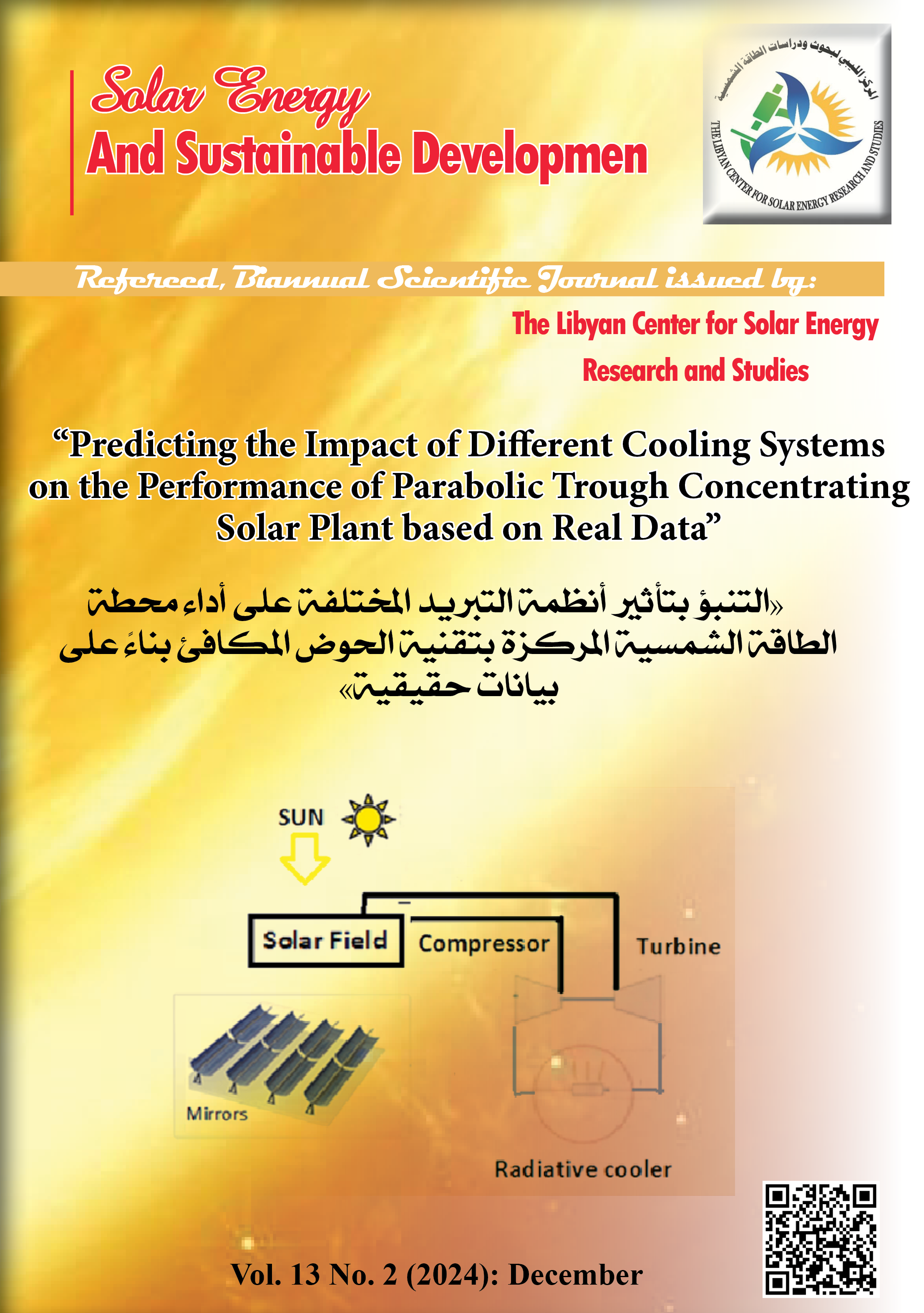Predicting the Impact of Different Cooling Systems on the Performance of Parabolic Trough Concentrating Solar Plant based on Real Data
DOI:
https://doi.org/10.51646/jsesd.v13i2.267Keywords:
Optimization, Radiative cooling system, Parabolic Trough Plant, optical performance., Andasol-1 plant.Abstract
By enhancing the availability and dispatchability of energy, concentrated solar power systems with thermal energy storage have a significant impact on tackling the issue of energy insecurity in hot and arid locations. However, these technologies currently face a number of difficulties. Additionally, the selection of the cooling system has a significant impact on how well a concentrated solar power plant performs. The primary three drawbacks of current cooling systems are their high water usage, high cost, limited availability of local water resources, and potential for localized disturbance. As a result, effective low-water cooling solutions for solar power concentration are highly desired. To achieve this, the study assesses the viability and advantages of adding a radiative cooling system to an indirect parabolic trough-concentrating solar thermal plant with two thermal energy storage tanks in arid regions of Algeria. This system is expected to improve the block and efficiency of the power plant and decrease energy costs and water volumes consumed. In order to evaluate these advantages, using the system advisor model software, a number of simulation models have been constructed including wet, dry, and radiative cooling systems with various configurations so that each strategy can be compared. The experimental statistics from the Andasol-1 plant in SPAIN that were documented in the literature were used for plant parameters. The results of the simulations were contrasted with a predetermined set of posted data from the Andasol-1 reference facility. In comparison to dry and wet cooling systems, the results show a rise in annual power generation and nearly 2.4 % and 11 % increase in the use of radiative cooling systems, respectively. Furthermore, the environmental assessment found that the annual water use may be reduced by 771209.7 m3, which would result in a possible annual water savings of more than 50%.
Downloads
Metrics
References
Aniekan Essienubong Ikpe , Ekpenyong Akanimo Udofia, Emmanuel Odeh; Thermodynamic Analysis of Hybrid-Nanofluids-Zeotropic Mixtures in a Vapour Compression Refrigeration System (VCRS) Based on Exergy Principles; Int. J. Res. Ind. Eng. Vol. 12, no. 2, pp.143–154 , 2023. https://doi.org/10.22105/riej.2023.383806.1365
Faisal Asfand, Patricia Palenzuela, Lidia Roca, Adèle Caron, Charles-André Lemarié, Jon Gillard, Peter Turner, and Kumar Patchigolla ; Thermodynamic Performance and Water Consumption of Hybrid Cooling System Configurations for Concentrated Solar Power Plants, Sustainability, vol. 12, 4739, 2020; https://doi.org/10.3390/su12114739.
Xu, X., Vignarooban, K., Xu, B., Hsu, K. & Kannan, A. M . Prospects and problems of concentrating solar power technologies for power generation in the desert regions. Renew. Sustain. Energy Rev. vol. 53, pp.1106–1131 ,2016.
Duniam, S., Jahn, I., Hooman, K., Lu, Y., & Veeraragavan, A . Comparison of direct and indirect natural draft dry cooling tower cooling of the sCO2 Brayton cycle for concentrated solar power plants. Applied Thermal Engineering, vol.130, pp.1070–1080 , 2018. https://doi.org/10.1016/j.applthermaleng.2017.10.169
Xiaohan Li, Yuwei Zhang, Ali Sorourkhah, S. A. Edalatpanah; Introducing Antifragility Analysis Algorithm for Assessing Digitalization Strategies of the Agricultural Economy in the Small Farming Section; Journal of the Knowledge Economy, November 2023. https://doi.org/10.1007/s13132-023-01558-5 ·
Islamoglu, Y. Modeling of thermal performance of a cooling tower using an artificial neural network. Heat Transfer Engineering, vol.26, no.4, pp. 73–76, 2005. https://doi.org/10.1080/01457630590916301.
Gao, M., Sun, F., Zhou, S., Shi, Y., Zhao, Y., & Wang, N. Performance prediction of wet cooling tower using artificial neural network under cross-wind conditions. International Journal of Thermal Sciences, vol.48, no.3, pp.583–589, (2009). https://doi.org/10.1016/j.ijthermalsci.2008.03.012.
Baweja, M., & Bartaria, V. N. A review on performance analysis of air-cooled condenser under various atmospheric conditions. International Journal of Modern Engineering Research, vol.3, no.1, pp.411–414, 2013.
Asvapoositkul, W., & Kuansathan, M. Comparative evaluation of hybrid (dry/wet) cooling tower performance. Applied Thermal Engineering, vol.71, no.1, pp. 83–93, 2014. https://doi.org/10.1016/j.applthermaleng.2014.06.023.
Huan.Ma,., Si, F., Li, L., Yan, W., & Zhu, K. Effects of ambient temperature and crosswind on thermoflow performance of the tower under energy balance of the indirect dry cooling system. Applied Thermal Engineering, vol.78 no.2, pp. 90–100, 2015. https://doi.org/10.1016/j.applthermaleng.2014.12.048
Nourani, Z., Naserbegi, A., Tayyebi, S., & Aghaie, M. Thermodynamic evaluation of hybrid cooling towers based on ambient temperature. Thermal Science and Engineering Progress, vol. 14, 100406, 2019. https://doi.org/10.1016/j.tsep.2019.100406.
Turchi, C. S., Wagner, M. J., & Kutscher, C. F. Water use in parabolic trough power plants: Summary results from Worley parsons' Analyses. National Renewable Energy Laboratory, 2010, USA, (NREL/TP-5500–49468), 1–108. https://www.nrel.gov/docs/fy11osti/49468.pdf
Habl, P., Blanco-Marigorta, A., & Erlach, B. Exergoeconomic comparison of wet and dry cooling technologies for the Rankine cycle of a solar thermal power plant. In: International Conference on Efficiency, Cost, Optimization, Simulation and Environmental Impact of Energy Systems , pp. 1–14, 2012.
Blanco-Marigorta, A. M., Sanchez-Henríquez, V. M., & Peña-Quintana, J. A. (2011). Exergetic comparison of two different cooling technologies for the power cycle of a thermal power plant. Energy, vol. 36, n.4, pp.1966–1972. https://doi.org/10.1016/j.energy.2010.09.033.
Cutillas, C. G., Ruiz, J., Asfand, F., Patchigolla, K. & Lucas, M (2021). Energetic, exergetic and environmental (3E) analyses of different cooling technologies (wet, dry, and hybrid) in a CSP thermal power plant. Case Stud. Therm. Eng. vol.28, 101545. https://doi.org/10.1016/j.csite.2021.101545
Carolina Marugán-Cruz, S. Sánchez-Delgado, J. Gómez-Hernández, D. Santana ; Towards zero water consumption in solar tower power plants; In progress: Applied Thermal Engineering, 2020,
https://doi.org/10.1016/j.applthermaleng.2020.115505.
Aseri Tarun Kumar · Chandan Sharma · Tara C. Kandpal ; Condenser cooling technologies for concentrating solar power plants: a review; Environment, Development and Sustainability, 06 August 2021, https://doi.org/10.1007/s10668-021-01678-5.
Henry, I., & Diemuodeke, O. E. Techno-economic comparison of wet and dry cooling systems for combined cycle power plants in different climatic zones. Energy Conversion and Management, vol.227, 113610. 2021. https://doi.org/10.1016/j.enconman.2020.113610
Shahab Rohani , Joachim Went , D. Frank Duvenhage , Ron Gerards , Christof Wittwer , Thomas Fluri; Optimization of water management plans for CSP plants through simulation of water consumption and cost of treatment based on operational data; Solar Energy , vol.223, pp. 278–292, 2021.
Alexander W. Dowling, Ana Dyreson, Franklin Miller, and Victor M. Zavala ; Economic Assessment and Optimal Operation of CSP Systems with TES in California Electricity Markets; SolarPACES 2016; AIP Conf. Proc. 1850, 160006-1–160006-9; https://doi.org/10.1063/1.4984540; Published by AIP Publishing. 978-0-7354-1522-5, (2016).
Dowling A. W, T. Zheng, and V. M. Zavala , Economic assessment of concentrated solar power technologies: A review; Renewable & Sustainable Energy Reviews, vol. 72, pp 1019-1032, 2017; https://doi.org/10.1016/j.rser.2017.01.006.
Mingeon Kim, Junyong Seo, Siwon Yoon, Heon Lee, Jungchul Lee, Bong Jae Lee (2021); Optimization and performance analysis of a multilayer structure for daytime radiative cooling; Journal of Quantitative Spectroscopy and Radiative Transfer, Vol. 260,107475, 2021.https://doi.org/10.1016/j.jqsrt.2020.107475.
Mingke Hu, Bin Zhao, Suhendri, Xianze Ao, Jingyu Cao, Qiliang Wang, Saffa Riffat, Yuehong Su, Gang Pei ; Applications of radiative sky cooling in solar energy systems: Progress, challenges, and prospects; Renewable and Sustainable Energy Reviews, vol. 160, 112304.2022.
Smith PS, Smith OJ. Apparatus for providing radiative heat rejection from a working fluid used in a Rankine cycle type system. Google Patents; 1981.
Dyreson Ana, Franklin Miller ; Night sky cooling for concentrating solar power plants; Applied Energy, vol. 180, pp.276–286, 2016.
Salman Ahmed, Zhenpeng Li, Muhammad Shahzad Javed, Tao Ma, A review on the integration of radiative cooling and solar energy harvesting, Materials Today Energy, vol.21,100776,2021.
Ablimit Aili. Yin, X. & Yang, R.; Global Radiative Sky Cooling Potential Adjusted for Population Density and Cooling Demand. Atmosphere (Basel). vol. 12, 1379, 2021.
Zhu, Y., Qian, H., Yang, R. & Zhao, D. Radiative sky cooling potential maps of China based on atmospheric spectral emissivity. Sol. Energy, vol. 218, pp.195–210, 2021.
Ablimit Aili, Gang Tan, Xiaobo Yin, Ronggui Yang ; Radiative cooling and cold storage for concentrated solar power plants; Energy Storage and Saving, vol.1, pp.93–101, 2022.
Ablimit Aili., Zhao, D., Tan, G., Yin, X. & Yang, R. Reduction of water consumption in thermal power plants with radiative sky cooling. Appl. Energy, vol. 302, pp.117515,2021a.
Zeyghami M, Khalili F. Performance improvement of dry-cooled advanced concentrating solar power plants using daytime radiative cooling. Energy Conversion & Management, vol.106, pp.10–20, 2015.
Espargilliere H, del Campo L, Echegut P, Py X, Muselli M, Rochier D . Applicability of CSP solar fields to the dry cooling of related thermodynamic cycles. Applied Thermal Engineering, vol. 127, pp.319–29, 2017.
Han Zhang, Tianxiang Hu, Bin Zhao , Gang Pei. Preliminary analysis of a parabolic trough concentrating solar power system integrated with radiative cooling. International Journal of Low-Carbon Technologies, 2024, 19, 1144–1159
https://doi.org/10.1093/ijlct/ctae050
Dersch.J, MichaelGeyer, UlfHerrmann, ScottA.Jones, BruceKelly .Trough integration into power plants: A study on the performance and economy of integrated solar combined cycle systems. Energy, vol. 29, pp.947–959, 2004.
Price. H, A parabolic trough solar power plant simulation model, Communication: International Solar Energy Conference (ASME), Hawaii Island, Hawaii, pp.665–673, 2003.
Michael J. Wagner and Paul Gilman. Technical Manual for the SAM Physical Trough Model. National Renewable Energy Laboratory, 2011, NREL/TP-5500-51825.
Martin. J. Atkins, Michael R.W. Walmsley .Integration of solar thermal for improved energy efficiency in low-temperature-pinch industrial processes. Energy, vol.35, pp.1867–1873, 2010.
Mihoub S, Chermiti A, Beltagy H. Methodology of determining the optimum performances of future concentrating solar thermal power plants in Algeria. Energy, vol. 122, pp. 801-810, 2017.
System Advisor Model (SAM) version 29.02.2020, accessed from https://sam.nrel.gov, 2020
Ibrahim Mohamed Ibrahim Eslayem, Mohamed Alamen Sharif; Study of the different Heat Transfer Fluids effect for a Linear Fresnel Power Plant designed in Sebha City, Libya; Academy journal for Basic and Applied Sciences (AJBAS) Volume 4 # 3 December 2022.
Biencinto. M, L. Gonzalez, L. Valenzuela, E. Zarza , A new concept of solar thermal power plants with large-aperture parabolic-trough collectors and sCO2 as working fluid, Energy Convers. Manage , vol.199, 112030, 2019.
“Andasol Power Plants” Solar Millennium. http://www.solarmillennium.de/Technologie/Referenzprojekte/Andasol
/Die_Andasol_Kraftwerke_entstehen_%2Clang2%2C109%2C155.html. (consulted 20 april 2024).
“Andasol-1” SolarPACES. National Renewable Energy Laboratory, October 2022. https://solarpaces.nrel.gov/project/andasol-1.(consulted 20 april 2024).
Ministry-of-Finance, 2019: http://www.mf.gov.dz/article/48/Zoom-sur-les-Chiffres-/154/Taux-d'inflation.html."
Zafar Said, Mokhtar Ghodbane, Boussad Boumeddane, Arun Kumar Tiwari, L. Syam Sundar, Changhe Li, Navid Aslfattahi, Evangelos Bellos, Energy, exergy, economic and environmental (4E) analysis of a parabolic trough solar collector using MXene based silicone oil nanofluids, Solar Energy Materials & Solar Cells, vol.239, 2022 .https://doi.org/10.1016/j.solmat.2022.111633
Mihoub. S, Design, Economic, and Environmental Assessments of Linear Fresnel Solar Power Plants, Environ. Prog. Sustain. Energy, Amer. Inst. Chem. Eng., vol. 39, no. 3, pp. 1–16, 2019. https://doi.org/10.1002/ep.13350.
Boukelia TE, Mecibah MS, Kumar BN, Reddy KS . Optimization, selection, and feasibility study of solar parabolic trough power plants for Algerian conditions. Energ Conver Manage, vol.101, pp.450-459, 2015.
“Ilanga-1” SolarPACES. National Renewable Energy Laboratory. https://solarpaces.nrel.gov/project/ilanga-i.

Downloads
Published
How to Cite
Issue
Section
License
Copyright (c) 2024 Solar Energy and Sustainable Development Journal

This work is licensed under a Creative Commons Attribution-NonCommercial 4.0 International License.













